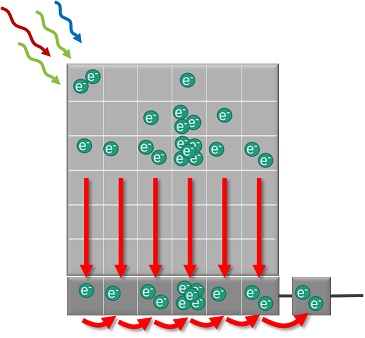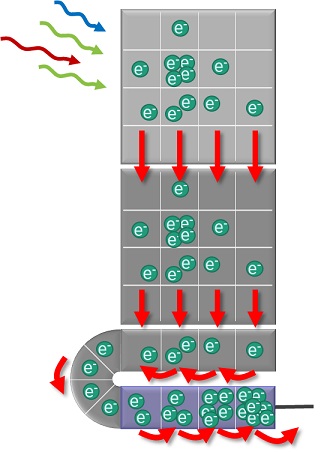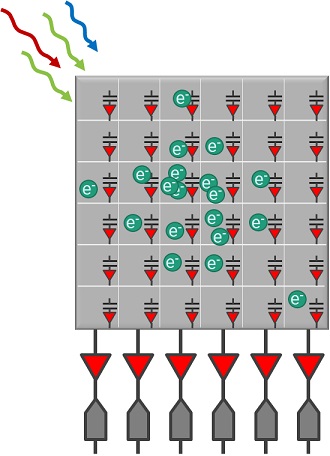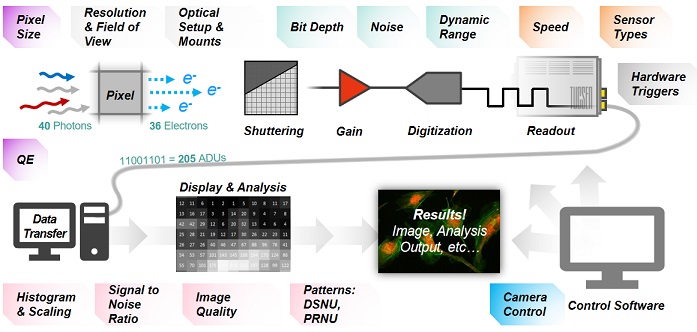What is the difference of CCD and CMOS camera?
CCD (Charge-Coupled Device) and CMOS (Complementary Metal-Oxide-Semiconductor) sensors are the two main types of image sensors used in digital cameras. They both perform the same task of capturing light and converting it into electrical signals, but they do so in different ways and have different strengths and weaknesses.
 |
 |
 |
|
CMOS sensors used for: Everything else!
|
EMCCD sensors used for:
Very low light imaging,
like single atom quantum imaging,
single photon imaging.
|
CMOS sensors used for: Everything else!
|
Here's a summary of the key differences:
1. Image Quality
CCD: CCD sensors traditionally provide superior image quality and light sensitivity. They have less image noise due to the method of charge transport, which tends to produce highter quality pixels.
CMOS: Earlier CMOS sensors were known for their lower image quality ompared to CCD sensors due to the additional on-chip components, which can interfere with light capture. However, modern CMOS sensors have significantly improved, and high-end CMOS now rival CCD in image quality.
2. Cost
CCD: CCD sensors are generally more expensive to produce due to their complex manufacturing process.
CMOS: CMOS sensors are less expensive to produce because they're fabricated on standard silicon production lines which makes them cheaper and faster to manufacture.
3. Power Consumption
CCD: CCD sensors consume more power because they require multiple clock signals during their operation. This can make them less suitable for battery-operated devices.
CMOS: CMOS sensors consume less power, as they function with a single power supply. This makes them ideal for portable and battery-operated devices.
4. Readout Speed
CCD: CCD sensors typically have slower readout speeds because they use a single amplifier to sequentially transfer and convert charge into voltage.
CMOS: CMOS sensors have faster readout speeds because each pixel has its own charge-to-voltage conversion, and the sensors can be read in a parallel manner.
5. Integration Capability
CCD: CCD technology is less adaptable to integration with other on-chip features.
CMOS: CMOS sensors can be easily integrated with on-chip microcontrollers, memory, and other circuits due to their manufacturing process, which is the same as most microprocessors and memory chips. This makes CMOS sensors ideal for systems requiring on-chip computational capabilities.
6. Shutter Mechanism
CCD: Many CCD sensors employ a global shutter, which exposes the entire sensor at once. This is ideal for capturing fast-moving objects without distortion.
CMOS: Most CMOS sensors use a rolling shutter, which exposes different parts of the frame at different times, leading to potential image distortion with fast-moving subjects. However, more advanced and modern CMOS sensors have global shutter capabilities.
Both CCD (Charge-Coupled Device) and CMOS (Complementary Metal-Oxide-Semiconductor) sensors are key imaging technologies used in digital cameras to convert light into electrons.
How does CCD or CMOS work?

CCD Sensors
1. When light hits the sensor, each pixel on the CCD sensor picks up the photons and stores them as a small electrical charge. The amount of charge is proportional to the intensity of light striking it.
2. The charges are then transferred across the sensor, from one pixel to the next, like a bucket brigade.
3. The last pixel in the row sends its charge to an amplifier, which converts the charge into a voltage. Then, an analog-to-digital converter (ADC) turns this voltage into a digital value.
4. These digital values form the image that was captured by the sensor.
The whole CCD sensor reads out the charge sequentially, one pixel at a time. This process is highly efficient, leading to high-quality, low-noise images.
CMOS Sensors
1. CMOS sensors also create electrical charges when they are hit by photons. However, instead of transferring the charge across the sensor, each pixel in a CMOS sensor has its own charge-to-voltage conversion.
2. This voltage is then amplified and converted to a digital value by an ADC right at the pixel site.
3. The digitized values are then sent across a wired network on the chip to be stored or further processed.
4. Unlike CCDs, which read out the charges sequentially, CMOS sensors convert the charge to a digital value at the location of each pixel, which speeds up the process. This means that CMOS sensors are generally faster than CCD sensors.